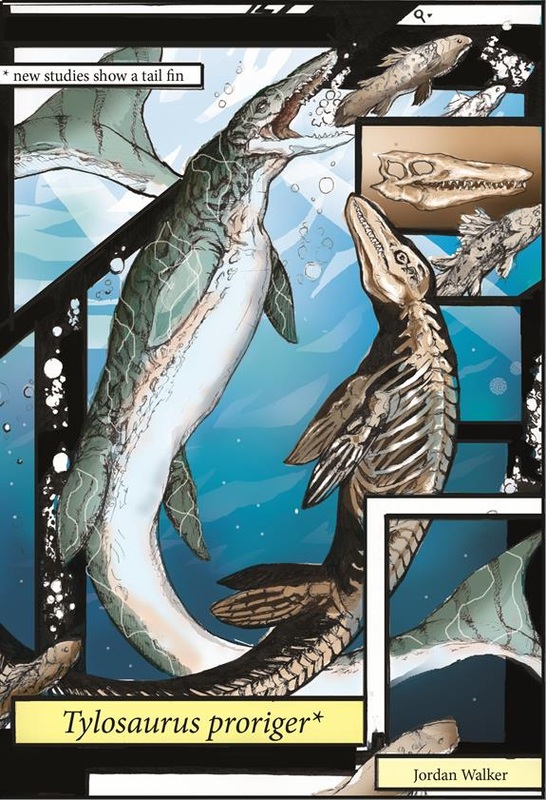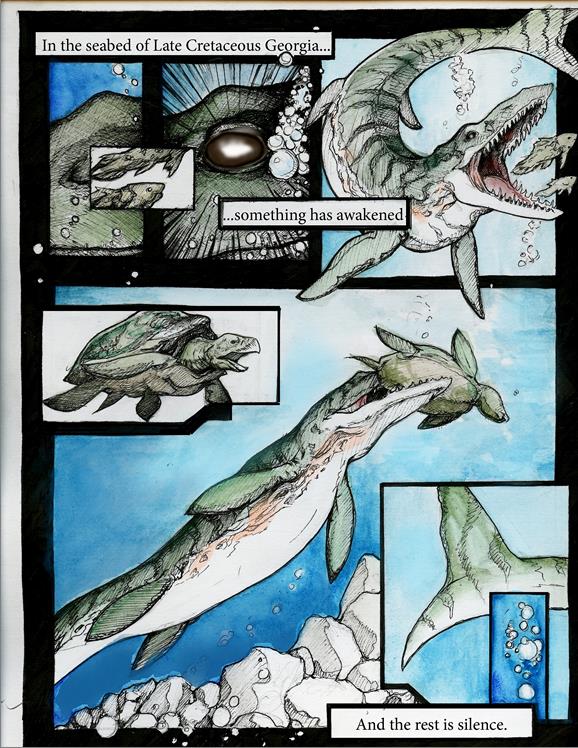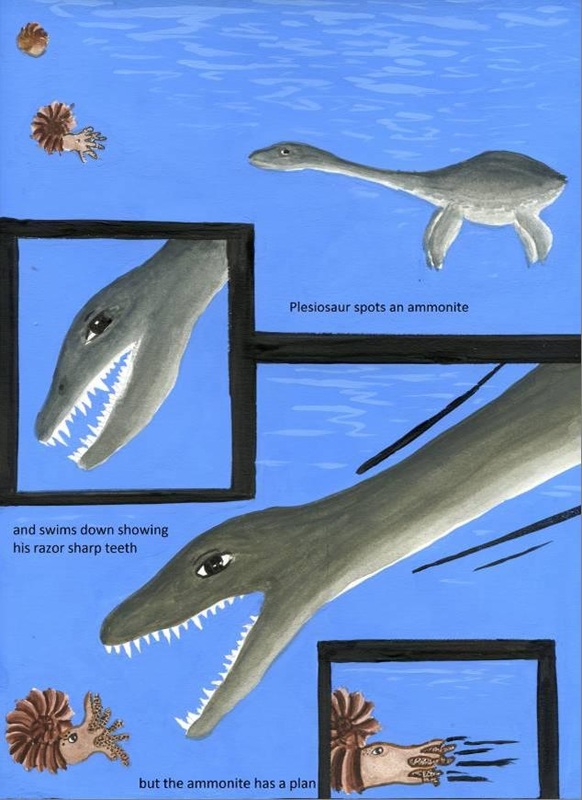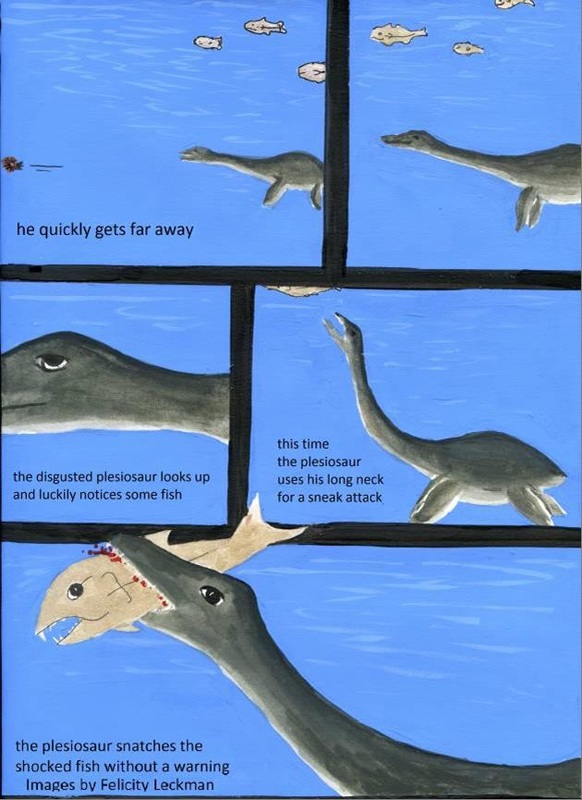7F: Marine Reptiles
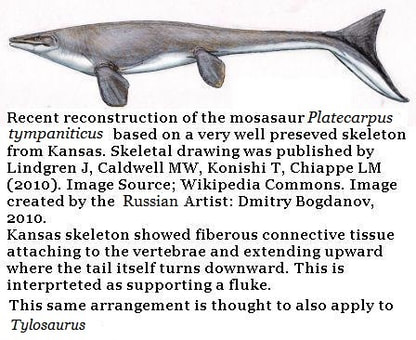
Mosasaurs
Scientists at Columbus State University have also identified fossils of at least two families of successful ocean going predatory reptiles from sediments in Georgia and Alabama; these are mosasaurs and plesiosaurs.
Mosasaurs and plesiosaurs were not dinosaurs. Dinosaurs are defined as land animals whose legs are vertically beneath them, not splayed to the sides like a lizard’s or an alligator’s.
Most of the mosasaurs and plesiosaurs finds from Georgia have been single bones which don’t allow for identification beyond saying it belong to a mosasaur or a plesiosaur, however sometimes scientists get lucky and find enough material to properly identify a species and confirm its presence, such was the case for the mosasaur monster genus Tylosaurus which has been confirmed in Georgia.
Mosasaurs had large heads, short necks and long tails. They were thought to swim alligator-like or ell-like until recently when it was shown in a 2010 research paper published by the Public Library of Science (www.plos.org) that one genus from Kansas Platecarpus tympaniticus possessed a fluke.
Current thought is that most mosasaurs including Tylosaurus would have also possessed a fluke.
Mosasaurs are related to lizards and snakes, closely related to modern monitor lizards. The mosasaur Tylosaurus was a large animal, specimens have been recovered which exceeded 45 feet in length. Mosasaurs in general are known from both deeper water environments and shallow coastal waters.
The genus Tylosaurus seems to have preferred shallow, coastal waters. There is a specimen on display at the Smithsonian’s National Museum of Natural History which contained the last meal of a plesiosaur in its stomach; it was discovered in 1918 by Charles H. Sternberg.
Mosasaurs feature importantly in the Bone Wars between the two famous early American paleontologists Edward Drinker Cope and Othniel Charles Marsh where they repeated re-assigned each other’s finds.
The images of the mosasaur Tylosaurus were created by the Artist Jordan Walker at Georgia Southwestern State University. Jordan has shown a hunting Tylosaurus with a fluke, or tail fin, which is accurate. Coelacanths are also shown in the image, which were present in Georgia’s Late Cretaceous sea but to date only the giant Megalocoelacanthus, which was too large a meal even for the giant Tylosaurus, is known to occur in Georgia. Jordan has also shown a sea turtle as prey, which is likely.
Scientists at Columbus State University have also identified fossils of at least two families of successful ocean going predatory reptiles from sediments in Georgia and Alabama; these are mosasaurs and plesiosaurs.
Mosasaurs and plesiosaurs were not dinosaurs. Dinosaurs are defined as land animals whose legs are vertically beneath them, not splayed to the sides like a lizard’s or an alligator’s.
Most of the mosasaurs and plesiosaurs finds from Georgia have been single bones which don’t allow for identification beyond saying it belong to a mosasaur or a plesiosaur, however sometimes scientists get lucky and find enough material to properly identify a species and confirm its presence, such was the case for the mosasaur monster genus Tylosaurus which has been confirmed in Georgia.
Mosasaurs had large heads, short necks and long tails. They were thought to swim alligator-like or ell-like until recently when it was shown in a 2010 research paper published by the Public Library of Science (www.plos.org) that one genus from Kansas Platecarpus tympaniticus possessed a fluke.
Current thought is that most mosasaurs including Tylosaurus would have also possessed a fluke.
Mosasaurs are related to lizards and snakes, closely related to modern monitor lizards. The mosasaur Tylosaurus was a large animal, specimens have been recovered which exceeded 45 feet in length. Mosasaurs in general are known from both deeper water environments and shallow coastal waters.
The genus Tylosaurus seems to have preferred shallow, coastal waters. There is a specimen on display at the Smithsonian’s National Museum of Natural History which contained the last meal of a plesiosaur in its stomach; it was discovered in 1918 by Charles H. Sternberg.
Mosasaurs feature importantly in the Bone Wars between the two famous early American paleontologists Edward Drinker Cope and Othniel Charles Marsh where they repeated re-assigned each other’s finds.
The images of the mosasaur Tylosaurus were created by the Artist Jordan Walker at Georgia Southwestern State University. Jordan has shown a hunting Tylosaurus with a fluke, or tail fin, which is accurate. Coelacanths are also shown in the image, which were present in Georgia’s Late Cretaceous sea but to date only the giant Megalocoelacanthus, which was too large a meal even for the giant Tylosaurus, is known to occur in Georgia. Jordan has also shown a sea turtle as prey, which is likely.
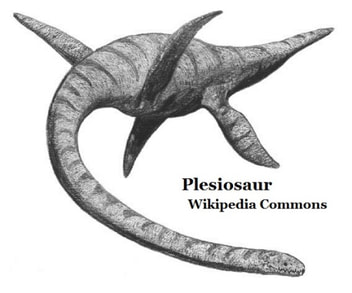
Plesiosaurs
Plesiosaurs are an opposite approach to hunting in the sea but can also be very large animals. They had small heads, very long necks and short tails; they swam by flapping their four large flippers and “flying” through the water.
Several species have been identified in Western Alabama. Georgia has produced several plesiosaur fossils, but not yet enough material from any single individual to confirm a species.
These are large animals; globally, the smallest known plesiosaur was about 2 meters (6.5ft) long with the largest being 20 meters (65ft) long.
Felicity Leckman at Georgia Southwestern created these two imaginative pages showing a plesiosaur during a successful hunt in Georgia’s Cretaceous sea, first missing an escaping ammonite, only to capture a passing saber-toothed Enchodus petrosus. I appreciate her participation in the project.
References:
Marine reptile fossil information on the species level comes from personal communications with David Schwimmer though it is mention in published reports:
Late Cretaceous Fish From The Blufftown Formation (Campanian) in Western Georgia. Gerard R. Case and David R. Schwimmer. Journal of Paleontology Vol.62 No. 2, 1988 The Paleontological Society
Plesiosaurs are an opposite approach to hunting in the sea but can also be very large animals. They had small heads, very long necks and short tails; they swam by flapping their four large flippers and “flying” through the water.
Several species have been identified in Western Alabama. Georgia has produced several plesiosaur fossils, but not yet enough material from any single individual to confirm a species.
These are large animals; globally, the smallest known plesiosaur was about 2 meters (6.5ft) long with the largest being 20 meters (65ft) long.
Felicity Leckman at Georgia Southwestern created these two imaginative pages showing a plesiosaur during a successful hunt in Georgia’s Cretaceous sea, first missing an escaping ammonite, only to capture a passing saber-toothed Enchodus petrosus. I appreciate her participation in the project.
References:
Marine reptile fossil information on the species level comes from personal communications with David Schwimmer though it is mention in published reports:
Late Cretaceous Fish From The Blufftown Formation (Campanian) in Western Georgia. Gerard R. Case and David R. Schwimmer. Journal of Paleontology Vol.62 No. 2, 1988 The Paleontological Society
